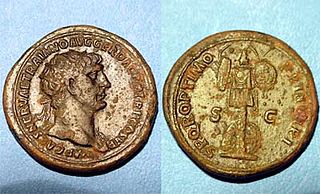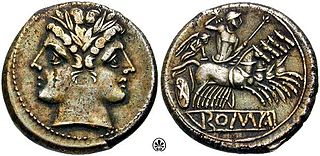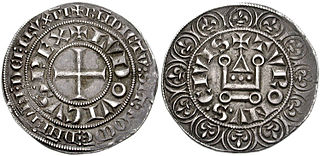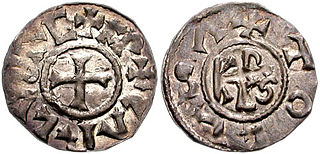
The denarius was the standard Roman silver coin from its introduction in the Second Punic War c. 211 BC to the reign of Gordian III, when it was gradually replaced by the antoninianus. It continued to be minted in very small quantities, likely for ceremonial purposes, until and through the Tetrarchy (293–313).

The as, occasionally assarius, was a bronze, and later copper, coin used during the Roman Republic and Roman Empire.

The sestertius or sesterce was an ancient Roman coin. During the Roman Republic it was a small, silver coin issued only on rare occasions. During the Roman Empire it was a large brass coin.

The dupondius was a brass coin used during the Roman Republic and Roman Empire valued at 2 asses.

Roman currency for most of Roman history consisted of gold, silver, bronze, orichalcum and copper coinage. From its introduction during the Republic, in the third century BC, through Imperial times, Roman currency saw many changes in form, denomination, and composition. A feature was the inflationary debasement and replacement of coins over the centuries. Notable examples of this followed the reforms of Diocletian. This trend continued with Byzantine currency.

The solidus or nomisma was a highly pure gold coin issued in the Later Roman Empire and Byzantine Empire. The early 4th century saw the solidus introduced in mintage as a successor to the aureus, which was permanently replaced thereafter by the new coin, whose weight of about 4.5 grams remained relatively constant for seven centuries.

The aureus was a gold coin of ancient Rome originally valued at 25 pure silver denarii. The aureus was regularly issued from the 1st century BC to the beginning of the 4th century AD, when it was replaced by the solidus. The aureus was about the same size as the denarius, but heavier.

The victoriatus was a silver coin issued during the Roman Republic from about 221 BC to 170 BC. The obverse of the coin featured the bust of Jupiter and the reverse featured Victory placing a wreath upon a trophy with the inscription "ROMA" in exergue. The name victoriatus is an ancient term, attested by several contemporary texts and inscriptions. The coin was known as a tropaikon among Greek speakers.

The quadrigatus was a medium-sized silver coin produced by the Roman Republic during the 3rd century BC. The obverse featured a young janiform bust and the reverse featured Victory driving a quadriga, giving the coin its Roman name, with the inscription "ROMA" below.

The pfennig ; symbol pf or ₰) or penny is a former German coin or note, which was the official currency from the 9th century until the introduction of the euro in 2002. While a valuable coin during the Middle Ages, it lost its value through the years and was the minor coin of the Mark currencies in the German Reich, West Germany and East Germany, and the reunified Germany until the introduction of the euro. Pfennig was also the name of the subunit of the Danzig mark (1922–1923) and the Danzig gulden (1923–1939) in the Free City of Danzig.

The Edict on Maximum Prices was issued in 301 AD by Diocletian. The document denounces greed and sets maximum prices and wages for all important articles and services.

The argenteus was a silver coin produced by the Roman Empire from the time of Diocletian's coinage reform in AD 294 to ca. AD 310. It was of similar weight and fineness to the denarius of the time of Nero. The coin was produced at a theoretical weight of 1/96th of a Roman pound, as indicated by the Roman numeral XCVI on the coin's reverse.
Roman Republican currency is the coinage struck by the various magistrates of the Roman Republic, to be used as legal tender. In modern times, the abbreviation RRC, "Roman Republican Coinage" originally the name of a reference work on the topic by Michael H. Crawford, has come to be used as an identifying tag for coins assigned a number in that work, such as RRC 367.

Groschen is the name for various coins, especially a silver coin used in parts of Europe such as France, some of the Italian states, England, various states of the Holy Roman Empire, among others. The word is borrowed from the late Latin description of a tornose, a grossus denarius Turnosus, in English the "thick denarius of Tours". Groschen was frequently abbreviated in old documents to gl, in which the second character was not an L, but an abbreviation symbol; later it was written as Gr or g.

The Heller, abbreviation hlr, was a coin, originally valued at half a pfennig, that was issued in Switzerland and states of the Holy Roman Empire, surviving in some European countries until the 20th century.

Silver coins are one of the oldest mass-produced form of coinage. Silver has been used as a coinage metal since the times of the Greeks; their silver drachmas were popular trade coins. The ancient Persians used silver coins between 612–330 BC. Before 1797, British pennies were made of silver.

Like the Egyptians, Phoenicians and Carthaginians, the Etruscans were rather slow to adopt the invention of coinage. The brief period of Etruscan coinage, with the predominance of marks of value, seems to be an amalgam that reconciles two very different monetary systems: the 'primitive' bronze-weighing and aes grave economy of central Italy with that of struck silver and gold issues of southern Italian Greek type not familiar in Etruria.

The sol, later called a sou, is the name of a number of different coins, for accounting or payment, dating from Antiquity to today. The name is derived from the late-Roman and Byzantine solidus. Its longevity of use anchored it in many expressions of the French language.

The coinage reform of Augustus refers to the reform of Roman currency undertaken by Augustus in 23 BC.

The Carolingian monetary system, also called the Carolingian coinage system or just the Carolingian system, was a currency structure introduced by Charlemagne in the late 8th century as part of a major reform, the effects of which subsequently dominated much of Europe, including Britain, for centuries. It is characterised by having three denominations with values in the ratio 1:20:240, the units of which went under different names in the different languages, but which corresponded to the Latin terms libra (pound), solidus (shilling) and denarius (penny), respectively.



















